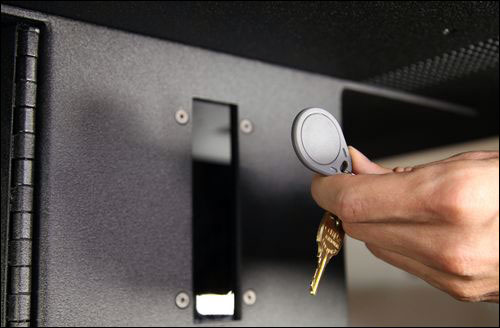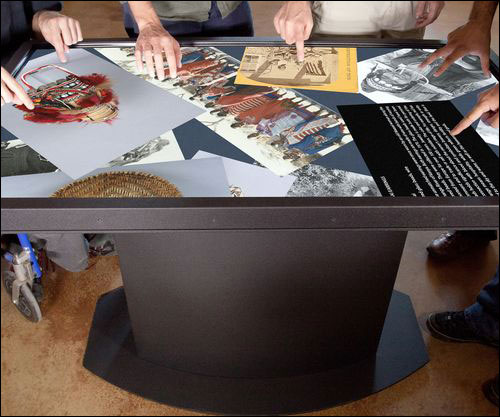Ideum, a manufacturer of custom multitouch exhibit tables for museums, universities, research labs, corporate boardrooms and other large, interactive environments, is building radio frequency identification technology into its fourth-generation models, thereby bringing functionality previously unavailable to the multitouch table market.
The Corrales, N.M.-based company expects to begin shipping its new RFID-enabled Pro and Platform touch tables by the end of this month, according to Jim Spadaccini, Ideum’s CEO, “including units to the National Park Service, the state of North Dakota and Boeing Corp., which has been a client of ours since generation 2 of the tables.”
An RFID reader is integrated into the side of each new model, says Jesse Sherr, Ideum’s exhibit technician, and every customer receives one or two key fobs containing an RFID tag. “The fob works like a switch,” Sherr explains. “It’s customizable. You can set certain levels of access so, for instance, the computer in the table won’t start unless the tag [in the fob] is in proximity.”
“We use the ID Innovations ID-12 RFID reader, which reads passive tags at 125 kHz using EM Microelectronic‘s EM41xx or compatible format,” says John Butler, Ideum’s software developer. “The reader has a built-in antenna, but has a pin-out for an external antenna to increase range. The internal antenna is rated at about 12 centimeters.”
The technology is brand-new to this line, Sherr notes. “We’re the first in the market to add RFID [to multitouch tables]. We can see hundreds of potential uses, [mainly] in public environments, especially in adding an extra layer of security.”
The customizable RFID system could also be programmed to activate additional layers of viewer information, Sherr says—in a map on an interactive surface of the display, for example—or to zoom in on a participatory portion of the screen.The key fob can serve as a sort of remote control, to trigger actions in an application or within the operating system. “Right now, the unit comes preconfigured to launch the keyboard,” Spadaccini states. “The RFID sensor interacts with an Arduino board [a relatively simple, open-source controller], so [customers] need to program the board. We will work with clients on custom applications once the tables start shipping.”
The table, composed of aircraft-grade aluminum for durability, incorporates a 55-inch LED LCD tabletop display with a surface 2 inches deep—thinner than that of other touch tables currently on the market, according to Sherr. The screen contains 40 simultaneous touch points and a 30,000,000:1 dynamic contrast ratio with 240 Hz technology, he says, as well as a high-quality touch sensor, designed to provide quality visuals under nearly all lighting conditions.

Both tables come with integrated computers, dedicated graphics processors, and Ethernet, Wi-Fi and Bluetooth communication cards, in addition to the RFID reader. The Pro model includes an expandable Hewlett-Packard workstation with a three-year, on-site warranty. According to the company, the Pro edges out the Platform version in terms of processing and graphics power, with its Intel i7-2600 3.4 GHz quad-core processor and nVidia Quadro 600 graphics card, compared with the Platform’s Intel i7 2720M 2.2 GHz dual-core processor and nVidia GX460 graphics card. The Pro unit also integrates a more powerful sound system.
The two models ship with Microsoft Windows 7 Professional software, and include a lifetime license for the GestureWorks software development kit. GestureWorks is Ideum’s authoring software for Adobe Systems‘ ActionScript, which incorporates the Gesture markup language for multitouch screens, essentially letting people use their hands to navigate around the tables’ flat, oversized glass displays. The Pro and Platform models also include a set of prefab Open Exhibits multitouch components, in order to facilitate display programming. Both versions are available in custom colors, as well as in standard black.
The RFID-enabled touch tables are “incredibly rugged—they’re built of the best-quality components,” Spadaccini says, noting that the tables carry a price tag starting at about $16,000, and are intended for “demanding environments—public exhibit spaces like museums, Fortune 500 boardrooms, educational institutions, research centers, retail spaces and so on.” The units are designed for quick setup and maintenance, he adds, and the RFID functionality can simplify administrative access, or allow for unobtrusive switching among display applications.
Spadaccini does not know specifically how Ideum’s customers plan to use the tables’ RFID functionality, but says he’s “excited about the potential.” In addition to the current orders for the RFID-enabled tables, he notes, “We’ve also gotten a custom request from a library that wants to use Near Field Communication for a virtual card-catalog system.”A virtual card catalog, Butler says, could be implemented to work in conjunction with NFC RFID tags and readers in several different ways, depending on a customer’s existing setup. One possible solution could involve a handheld interrogator that communicates with the touch table via a wireless or USB connection for cataloging and tracking. Individual items, fitted with NFC passive RFID tags, could be placed near the table so that users could view more extensive metadata or collection information.
“We would need more information on the client’s specific requirements before we could engineer a custom solution,” Butler adds.
Why RFID, Why Now?
The 12-year-old company, which started as a developer of museum exhibits and Web sites, “got perspective from developing custom software and hardware—we’ve learned what works and what doesn’t,” Spadaccini says. “RFID seemed like a simple way to provide administrative access without having to break out a keyboard. You can have access [to the display] through a key fob, you don’t have to haul around a keyboard in a public space, and we think people will find other uses for it as well. So it made sense to incorporate it at a basic level, and add our creative ideas to it.
“We’re always interested in increasing the capabilities of our products, making them more useful for our end users,” Spadaccini adds. “Eighty to 90 percent of our clients use [the tables] in lockdown situations, so RFID offers a simple, elegant way to check on system settings and applications when, let’s say, you have a group of visiting dignitaries, and you want to bring up a screen without having to pull out a keyboard.”
The company employs “standard RFID components” to ensure reliability, Sherr says, and performs all table assembly, including the integration of the readers and tags, on site in New Mexico.
“If you’ve never stood at the side of one of these tables,” Sherr says, “it’s pretty fascinating to be able to interactively use your hands in the computer environment to access different levels of information, and write with your hands rather than with the traditional Windows-mouse-pointer interface. RFID just adds an invisible layer of interactive magic.”


